Sights on the island of Zakynthos
The island of Zakynthos, a beautiful green island with amazing nature, in the area of preserved historical monuments but unfortunately marked by the tragic event of 1953, when a strong earthquake occurred. The earthquake, followed by extensive fires, destroyed almost all the buildings in the capital and left repercussions all over the island.
However, the people of the island have earned great admiration because they have managed to restore the capital and other monuments, some of them even to their original buildings, thus preserving their historical legacy for future generations. It is not only in the architecture and historical monuments that the Venetian influence is particularly evident throughout the island.
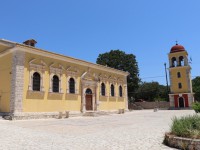
Church of Panagia Keriotissa
Church of Our Lady of Keriotissa (Keri)
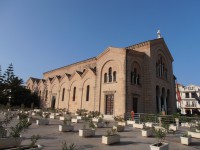
Church of Saint Dionysius
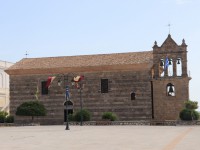
Church of Saint Nicholas (Zante)
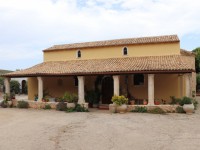
Monastery of Anafonitria
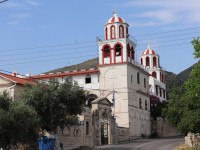
Monastery of Eleftherotria (Maherado)
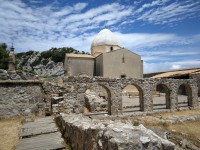
Monastery of Panagia Skopiotissa
Monastery of Our Lady of Skopiotissa (Argassi)
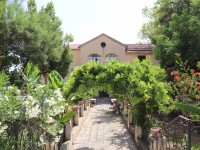
Museum and residence of the Romas family
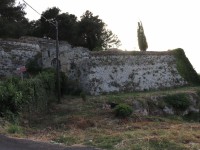
Ruins of Bochali Castle
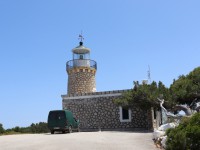
Skinari Lighthouse
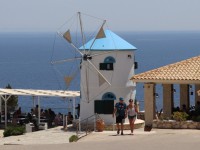
Skinari Windmill
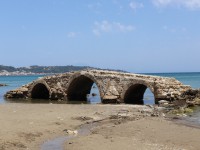
Venetian Bridge in Argassi
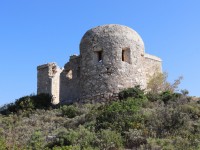
Venetian Tower
Architecture and cultural monuments in the capital of Zakynthos
In the period before the devastating earthquake, the capital of Zakynthos was decorated with historical monuments and contemporary elegant buildings, as well as several beautiful churches, and many bourgeois buildings and ordinary houses were built. The Venetian influence also promoted the new construction of public buildings, roads and bridges.
In 1953, an earthquake and subsequent fire caused a major disaster in the capital of Zakynthos, as almost the entire city was destroyed. Only three important buildings remained, namely the Cathedral of St. Dionysius, the National Bank building and the Church of St. Nikolas. The subsequent reconstruction of the capital was very extensive and difficult in order to preserve the beauty and charm of Zante before the event. The arches are an architectural feature that was typical of the pre-earthquake period and was also used in the renovation of important historical buildings.
There are several picturesque squares in the capital Zante. St Mark's Square used to be the centre of Zakynthos' cultural life. During the period of Venetian rule, the nobility, the rich and the generally important people of Zakynthos gathered in the local caf├ę (casino). And it was in this square that in 1797 the poor citizens revolted and burned the famous "Libro D'oro" (Book of the Nobles) as a symbol of their liberation from the Venetians. Today, St. Mark's Square is a lively tourist spot with taverns, caf├ęs and all kinds of shops.
In St. Mark's Square stands the Solomos and Kalvos Museum, which introduces visitors to life on the island in past centuries through artworks and personal objects of the two important poets, as well as historical art objects of other important figures of Zakynthos.
Dionysios Solomos is an important Greek poet, known as the author of the lyrics of the national anthem and the poem "Eleftheri Poliorkimeni". According to legend, he wrote this poem while sitting under a tree on Stranis Hill. A bust of Solomos is placed on the hill in memory of the artist.
In honour of Dionysios Solomos, a square was named in the capital, the largest and supposedly the most charming square on the island of Zakynthos, where there is also a statue of this important Greek poet with a line of his poem "Hymn to Freedom" engraved on it. In the foreground is another statue representing Glory, to whom the poet speaks through his poems.
Solomos Square is home to several historically and culturally significant buildings - the Byzantine Museum, with its extensive and unique collection of historical objects from different parts of the island, and the Church of St. Nicholas, the oldest Venetian building in the capital of Zakynthos. The large building on the square houses the Town Hall Library. In addition to photographs of Zakynthos before the 1953 earthquake, the library also holds rare books on Zakynthos history and tradition, works by famous writers and copies of old newspapers.
The ruins of the Venetian castle of Bochali stand out on the hill above the capital, which today also serves as a popular viewpoint, as from the top of the hill one can observe the capital of Zakynthos, as well as other parts of the island and the blue distances of the Ionian Sea. In the past, the site of the castle ruins was the site of the medieval town of Zakynthos, with many houses and several churches.
Museums on the island of Zakynthos
In the capital city of Zante, in Solomos Square, is the much-visited Byzantine Museum of Zakynthos. The museum's extensive collection is spread over both floors of the building and gradually reveals to visitors Byzantine icons carved from wood, original frescoes from the 15th to 17th centuries, paintings from the 18th century and oils on canvas by artists such as Doxaras, Koutouzis and Kantouni. Many of the works depict the capital of Zakynthos before the earthquake and thus offer an interesting comparison with the present-day city. The museum's collection also includes modern Greek art.
Nearby, in St. Mark's Square, is the D. Solomos and A. Kalvo Museum, which was founded in the mid-20th century by a club of art admirers in Zakynthos. Dionysios Solomos and Andreas Kalvos were important national poets and, interestingly, the museum also preserves their relics. In the museum, visitors can see many portraits dedicated to the most important citizens of Zakynthos, a collection of coats of arms, as well as paintings from the 18th and 19th centuries, carved ceramics, sculptures, old musical instruments and, for example, weapons of noble families of the last century.
In the capital of Zakynthos there is also the Museum of the Romas family, one of the leading and oldest aristocratic families on the island. Alexander Romas was one of the most important figures in modern Greek political and military history, and was also a cabinet minister and speaker of the Greek parliament. The large family mansion was reconstructed after the earthquake and later turned into a museum.
However, smaller and thematic museums can also be found outside the capital, Zakynthos. In the popular holiday resort of Tsilivi, tourists can visit the Milanio Maritime Museum, which provides an engaging summary of the island's maritime history from the earliest times to the present day. The collection includes watercolours depicting the development of shipping as well as a wide range of Byzantine ships from the beginning of the Byzantine Empire to its destruction by the Turks in 1453.
The lively seaside resort of Laganas houses another interesting collection in the form of the Historical War Museum in the courtyard of the Galaxy Beach Resort. The unique three-dimensional museum depicts the participation of Greek soldiers in the major wars of the 20th century - the Vietnam War, the Korean War and World War II. Exhibits on display include original weapons, uniforms, field equipment, vehicles and other artifacts from these wartime conflicts.
The Helmis Natural History Museum is part of the inland municipality of Agia Marina and its collections include specimens of flora and fauna of Zakynthos nature, especially rocks and minerals, plant and animal fossils, shells, fish, birds or butterflies.
In the small village of Pigadakia (not far from the resort of Alykes) there is a small Cultural and Agricultural Museum dedicated to the history and traditions of the Greek countryside, displaying historical working tools, agricultural machinery used for grinding grain and pressing grapes and olives, as well as rare works of local craftsmanship from the 16th century.
Churches and monasteries on Zakynthos
The bell towers attached to the three-aisled basilicas are characteristic of the churches of Zakynthos.
The most prominent church on the island is Agios Dionysios, the church of Saint Dionysios, which stands on the waterfront of the capital Zante. Dedicated to St. Dionysios, the protector of Zakynthos, the church is one of the finest examples of Venetian architecture in Greece. It was built in its present form in 1948 and managed to withstand a strong earthquake a few years later. The interior of the church is richly decorated with frescoes, paintings, large chandeliers, golden elements and the relics of St. Dionysus are also kept in a silver coffin. The church also includes a tall white bell tower and at night the church and the bell tower are beautifully lit.
From the other side of the harbour, on D. Soloma, the church of St. Nicholas (Agios Nikolaos Molos), which dates from the 16th century and is the oldest Venetian building in Zakynthos. It is a single-nave, stone basilica, decorated inside with murals, icons and other religious jewels.
In the nearby St. Mark's Square, we find the small church of St. Mark, which is unique among other Zakynthos churches for being Catholic. It stands right next to the D. Solomos and A. Kalva Museum.
The Monastery of Our Lady of Skopiotissa (Panagia Skopiotissa) stands on the top of Mount Skopos, in the southeastern part of Zakynthos. The current form of the church dates from the 17th century, but the entire monastery complex is one of the oldest on the island.
On the southern tip of the island is the Monastery of Our Lady of Keriotissa (Panagia Keriotissa) with a beautiful courtyard and a large bell tower whose bells can be heard throughout the mountain village of Keri. The date of the church's foundation is unknown, but it acquired its present form in the 18th century. The church of Panagia Keriotissa also protects an ancient image of the Virgin Mary, to which a legend is attached.
The Monastery of Eleftherotria, or the Monastery of the Holy Mother Liberator, stands in the interior of Zakynthos, near the village of Maherado, and probably dates from the 15th century. The Eleftherotria Monastery is beautiful, well-maintained and very specific - from the outside it looks more like a castle than a monastery, characterised by its battlements and arches and the colours red and white. At present it is a women's convent.
Lovers of Greek architecture also head to the village of Anafonitria, which includes the magnificent 15th century Anafonitria Monastery, dedicated to the Virgin Mary. The history of the monastery is also linked to St. Dionysus, the patron saint of the island, who is said to have spent the last years of his life here. The monastery is located in the northwestern part of Zakynthos, surrounded by greenery, and at first glance it catches the eye with its tower, which stands right at the entrance. The partially ruined tower, built as a defensive tower, was later used as a bell tower. The main part of the monastery is the church with the plan of a three-aisled basilica, decorated inside with frescoes and paintings and housing a precious icon of the Virgin Mary.
Nearby, between Anafonitria and Volimes, stands the monastery of Agios Georgios Gremnon (or Krimnon). The monastery dates back to the 16th century and was one of the most important monasteries on the island, where the historical monk Pahomios Rousianos and Saint Gerasimos, patron saint of Kefalonia, spent part of their lives. According to legend, the monastery of Agios Georgios Gremnon was attacked and destroyed by pirates and rebuilt in the 17th century in the Venetian style. The monastery stands on the edge of a cliff (hence "gremnon", meaning "cliff"), near the viewpoint of the famous Navagio Bay.
Other interesting historical sites on Zakynthos
The popular tourist resort of Argassi boasts not only nice beach hotels, but also one attraction located right in their view. Right on the beach are the remains of the ancient Venetian Argassi Bridge, built in the early 19th century. The bridge used to be part of the main Zakynthos road, but today the remains of the historic bridge are half in the sand and half in the sea.
Behind the village of Argassi, the countryside hides another historical attraction, the Vrysakia Aqueduct, which was used in the past to supply water to the whole area. The remains of the aqueduct are well preserved and accessible by a small unpaved road leading from Argassi towards the green countryside inland.
A small but well-preserved Venetian tower still stands on the western coast of the island. The tower was built as a watchtower and was used as a place to observe possible enemies coming from the sea. It was ideally situated for this purpose, as from the site you can see most of the western coast of the island. The Venetian tower is reached via the village of Exo Chora.
If you make your way to the very northern tip of the island, you will find the Skinari Lighthouse still active and several historic stone windmills, two of which have been converted into guest accommodation. The Skinari stone lighthouse was built in the late 19th century and is now a protected monument.
Zakynthos and traditional Greek villages
One of the oldest villages on Zakynthos is the village of Gyri, which was founded in the 15th century on the western coast of the island. Gyri is a very quiet village with an old church and one of the highest villages on Zakynthos.
The villages that remain true to traditional Greek architecture are primarily Keri, Maherado, Maries and Volimes.
Map of Zakynthos - Sights
The most important and most visited sights of Zakynthos, as well as the lesser-known but interesting ones, are clearly marked on the map of Zakynthos.
